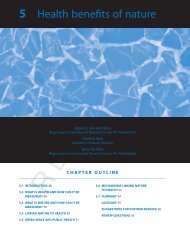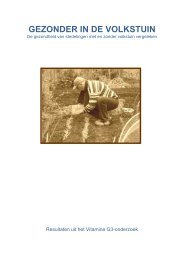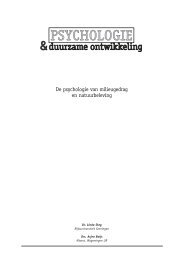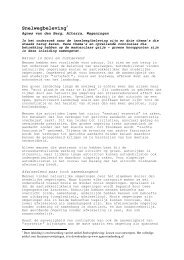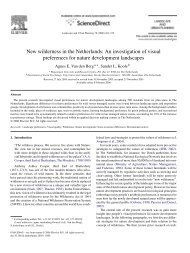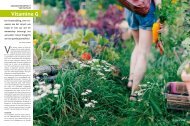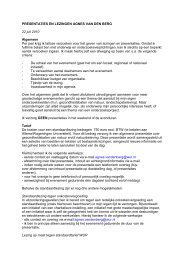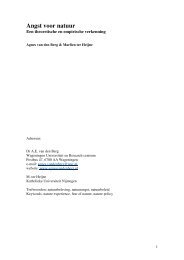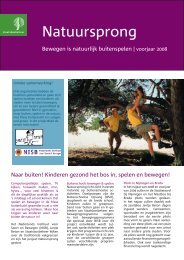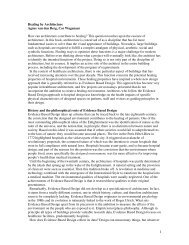Is love for green in our genes? - Agnes van den Berg
Is love for green in our genes? - Agnes van den Berg
Is love for green in our genes? - Agnes van den Berg
- No tags were found...
Create successful ePaper yourself
Turn your PDF publications into a flip-book with our unique Google optimized e-Paper software.
ARTICLE IN PRESS2Y. Joye, A. <strong>van</strong> <strong>den</strong> <strong>Berg</strong> / Urban Forestry & Urban Green<strong>in</strong>g xxx (2011) xxx–xxx“psycho-evolutionary framework” underly<strong>in</strong>g SRT, RogerUlrich (1983) ma<strong>in</strong>ly explored the possible proximate causes ofrestoration <strong>in</strong>duced by natural environments. These are theimmediate devel- opmental (ontogenetic) and mechanic causes ofa certa<strong>in</strong> behavi<strong>our</strong> or trait. Based on the empirical work of RobertZajonc (1980), Ulrich (1983) argued that the <strong>in</strong>itial response modeto environments and environmental stimuli is one ofgeneralized affect. Characteris- tic to such affective responses isthat they are deemed to occur almost immediately afterexposure to the stimulus or environ- ment, to require only littlecognitive process<strong>in</strong>g, and to take place without consciousrecognition. This <strong>in</strong>itial affective response mode is believed tohave prehistoric roots and to have been reta<strong>in</strong>ed across thehuman l<strong>in</strong>eage because it contributed to <strong>our</strong> species’ survival.Ulrich (1983, 1986) specified a number of specific environmentalfeatures or “preferenda” that are able to trigger <strong>in</strong>itial positiveaffective responses. These <strong>in</strong>clude “complexity”, “gross structuralfeatures” (e.g., symmetries), “depth/spatiality cues”, “even groundsurface texture”, “deflected vista”, and “absence of threats”. What<strong>in</strong>terests us most, however, is that Ulrich (1983) also conjecturedthat exposure to unthreaten<strong>in</strong>g natural environments or to certa<strong>in</strong>types of unthreaten<strong>in</strong>g natural content (e.g., vegetation) will offsetsuch immediate positive affective responses. When previousto encounters with such natural sett<strong>in</strong>gs/elements an <strong>in</strong>dividualwas <strong>in</strong> a negative mood or experienced stress, then theposi- tive responses <strong>in</strong>duced by nature could attenuate thosenegative feel<strong>in</strong>gs/states, and restoration might follow. Or, assummarized by Ulrich (1983, p. 116): “For <strong>in</strong>dividualsexperienc<strong>in</strong>g stress or anxiety, most unthreaten<strong>in</strong>g naturalviews may be more arousal reduc<strong>in</strong>g and tend to elicit morepositively toned emotional reac- tions than the vast majority ofurban scenes, and hence are more restorative <strong>in</strong> apsychophysiological sense”.Accord<strong>in</strong>g to SRT, restorative responses can thus essentiallybe considered as by-products of immediate positive affectiveresponses <strong>in</strong>duced by (unthreaten<strong>in</strong>g) natural sett<strong>in</strong>gs. Note thatthe centrality of affect <strong>in</strong> SRT marks an important differencewith the other major theory on restorative environments, AttentionRestoration Theory (ART), which assumes that the proximatecause of restoration lies <strong>in</strong> the replenishment of depleted cognitiveres<strong>our</strong>ces (Kaplan and Kaplan, 1989). Of further importance is thatSRT assumes that the l<strong>in</strong>k between positive affect and restorativeresponses is specific to natural environments: “. . . modern humans,as a partly genetic remnant of evolution, have a biologically preparedcapacity <strong>for</strong> acquir<strong>in</strong>g and reta<strong>in</strong><strong>in</strong>g restorative responses tocerta<strong>in</strong> natural sett<strong>in</strong>gs and content . . . but have no such disposition<strong>for</strong> most built environments and their materials” (Ulrich, 1999,p. 52). But why would it have been beneficial <strong>for</strong> humans to evolvesuch a capacity? This question taps <strong>in</strong>to the ultimate or evolutionarycauses of restorative responses to nature, which are the focusof this article.Ultimate explanations of restorative responses to natureDifferent ultimate explanations run through Ulrich’s psychoevolutionaryframework. For example, Ulrich notes that whena stressor has disappeared the <strong>in</strong>ci<strong>den</strong>ce of stress reduction “...would enhance survival chances <strong>in</strong> part because of its role <strong>in</strong>promot<strong>in</strong>g recovery from fatigue and other deleterious effectsstemm<strong>in</strong>g from behav<strong>in</strong>g adaptively <strong>in</strong> a previous demand<strong>in</strong>gsituation” (Ulrich,1993, p. 98). It is <strong>in</strong>deed a well-known fact that after astress- ful episode a failure to return to basel<strong>in</strong>e levels ofarousal may have detrimental health consequences and thusmay have low- ered survival chances (Selye, 1956). While thisaccount perhaps provides an ultimate explanation <strong>for</strong> theprevalence of a general stress reduction response, it must beclear that this is not the type of “restorative” response envisionedby SRT.The central idea underly<strong>in</strong>g SRT is that human <strong>in</strong>dividuals morequickly and more deeply recover from stress near unthreaten<strong>in</strong>gnatural elements and sett<strong>in</strong>gs than near unthreaten<strong>in</strong>g urban environments.As noted earlier, this particular restoration process issupposed to be driven by the differential affective valence of naturalversus urban sett<strong>in</strong>gs. S<strong>in</strong>ce the 1980s there seems to be an(implicit) consensus among restorative environments researchersthat the occurrence of these affective responses is “.. affected byunlearned factors of evolutionary orig<strong>in</strong>” (Ulrich, 1983, p. 115), andthat they need to be considered as remnants of <strong>our</strong> species’ evolution<strong>in</strong> natural environments. Of further importance is that it ismostly assumed that these (positive) affective reactions are evolvedadaptations. Display<strong>in</strong>g such responses to nature fulfilled a particularfunction <strong>in</strong> ancestral environments and “. . . tended to foster[human] survival and well-be<strong>in</strong>g dur<strong>in</strong>g evolution” (Ulrich et al.,1991, p. 209).It must be clear that the <strong>for</strong>ego<strong>in</strong>g account still leaves a numberof questions unanswered. For example, <strong>in</strong> what respect did positiveaffective responses to unthreaten<strong>in</strong>g nature exactly foster survivaldur<strong>in</strong>g <strong>our</strong> species’ evolutionary history? With<strong>in</strong> the restorativeenvironments research field it is generally assumed that some naturalcontent could offer ancestral humans opportunities <strong>for</strong> safety,could conta<strong>in</strong> food res<strong>our</strong>ces, or at least could have been <strong>in</strong>dicativeof the presence of food or safety (cfr., Ulrich et al., 1991, p. 226).Hav<strong>in</strong>g evolved a hardwired ten<strong>den</strong>cy or “preparedness” to displaypositive affective responses to such natural content would have<strong>in</strong>creased ancestral humans’ survival chances because it motivatedthem to pay attention to, or to approach or stay <strong>in</strong> environmentsthat conta<strong>in</strong>ed elements or opportunities that were critical to theirsubsistence (i.e., food and safety).Another issue relates to the type of nature toward which <strong>our</strong>species is supposed to have evolved positive affective responses.Although the empirical and theoretical literature associated withSRT is not very often outspoken on this matter, three general categoriesof “restorative nature” can be i<strong>den</strong>tified. First, on numerousoccasions it is proposed that exposure to unthreaten<strong>in</strong>g naturalsett<strong>in</strong>gs can elicit these immediate positive affective responses.Ulrich (1993, p. 102), <strong>for</strong> example, notes that “[c]onsistent withthe functional-evolutionary perspective . . . view<strong>in</strong>g unthreaten<strong>in</strong>gnatural landscapes tends to promote faster and more completerestoration than . . . urban or built environments”. A second categoryof restorative nature is vegetative elements, or sett<strong>in</strong>gsconta<strong>in</strong><strong>in</strong>g such elements. The reason <strong>for</strong> <strong>in</strong>clud<strong>in</strong>g this categoryderives from the fact that restorative effects are often triggered byvegetated scenes, a f<strong>in</strong>d<strong>in</strong>g that is generally regarded to becon- sistent with, and support<strong>in</strong>g the evolutionary tenets of SRT(cfr., Ulrich et al., 1991). The third and last category of naturalcontent is more specific than the two previous ones, and <strong>in</strong>cludesspecific types of natural sett<strong>in</strong>gs or features that are supposed tofacilitate stress reduction. Ulrich (2008, p. 90) po<strong>in</strong>ts out that thesecan com- prise elements/features like “calm or slowly mov<strong>in</strong>gwater, verdant vegetation, flowers, sa<strong>van</strong>na-like or parklikeproperties. . .”.Based on the previous discussion, SRT’s ultimate account <strong>for</strong>restorative responses to nature can be summarized as follows.A biologically prepared read<strong>in</strong>ess to display positive affectiveresponses to different types of unthreaten<strong>in</strong>g natural content isan evolved adaptive mechanism (Ulrich, 2008, p. 89), whose functionwas to guide and support <strong>our</strong> ancestors <strong>in</strong> the processof f<strong>in</strong>d<strong>in</strong>g food, water and shelter <strong>in</strong> ancestral environments.When hav<strong>in</strong>g experienced a stressful episode, exposure to naturalcontent provid<strong>in</strong>g food/water/shelter can lead to stress reductionvia the (psychologically and physiologically) sooth<strong>in</strong>g effects ofpositive affect (Ulrich, 2008). The fact that, on an evolutionarytime-scale, <strong>our</strong> species has only recently begun to construct and<strong>in</strong>habit built environments, but has experienced the “.. rewardsassociated with natural sett<strong>in</strong>gs dur<strong>in</strong>g a few million years ofevolution” (Ulrich



